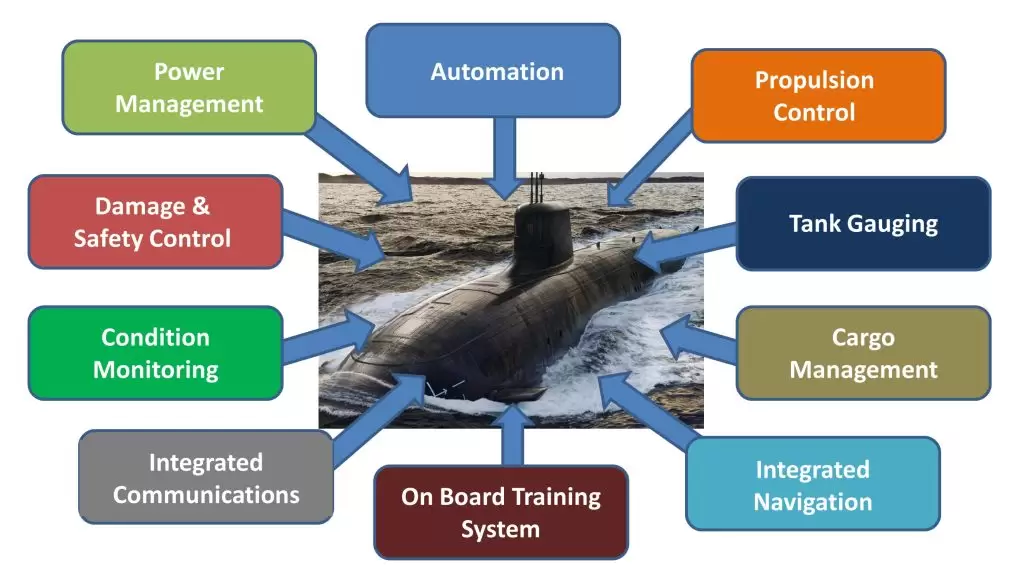“Are you making the right decision?” asks HAL 9000 in the seminal 1968 novel 2001: A Space Odyssey, “I think we should stop.” Whether you agree with ceding more control to computers or are against such a level of intuitive autonomy, we live, as we’re constantly reminded, in a connected world.
But what does this mean for surface and submersible grey ships?
The past decade has brought leading-edge technology to areas that have previously only used tried and tested technology with proven reliability over decades. The sheer amount of data that modern communication systems have to handle has increased exponentially.
This is partially driven by the use of serial interfaces and ethernet connections that can transmit packages of data from a series of sensors through a single cable, rather than relying on individual cabled connection points for each sensor.
Integrated systems
A typical grey ship, or military vessel, may have 15,000 sensors — inputs — and actuators — outputs — that have to be read or written to in a fraction of a second. The ability to handle this payload of information has been made possible by the continual advances in computer power and programmable logic controllers (PLC) used in systems.
More than 10 separate systems operate simultaneously to form the basis of modern alarm management and control systems (AMS), and integrated platform management systems (IPMS), such as those used on the military afloat reach and sustainability, or MARS, vessels that support the newest aircraft carriers.
The proposed AUKUS ships will use the 200 to 300 MW PWR3 reactor, a simpler and longer life reactor designed to operate for 33 years compared to the PWR2, which has a 25 year life without refuelling.
With 30 per cent fewer parts than the PWR2 reactor currently used, it will essentially be a “black box” to be managed automatically by AI, automation and satellite communication via a tethered or untethered buoy, with minimum involvement required by the crew.
This black box will take inputs and provide outputs to integrated systems, controlling everything from power management to navigation.
AI will also increasingly be used for “friend-or-foe” identification, stealth optimisation through sound and vibration monitoring and control, and automatic countermeasures to protect the vessel.

Evolving hardware
It isn’t just the profusion of sensor-bearing equipment adding to the data load, but also the key equipment itself has developed a vast number of sensor points.
Ten years ago in a Rolls-Royce MTU engine, there may have been 10 sensors. Now every crank and every mechanical component is monitored, with a temperature or oil pressure sensor taking the sensor count on one engine into the hundreds.
The key challenge is to turn the data generated from these sensors into information that can be acted on to drive further results, performance improvements, condition-based monitoring (CBM), preventable and predictable failure maintenance and autonomous automation control. It also means the crew can plan their docking period and location more accurately and effectively.
CBM is probably one of the biggest areas of application for predictive data analysis. Big data allows time-based scheduled equipment maintenance to go to far more efficient CBM, avoiding costly, mistake-prone inspections of equipment.
CBM is a key component of reliability centred maintenance (RCM), which was adopted by the British Royal Navy following trials in the HUNT Class vessels, which indicated a 40 per cent reduction in through-life materials and maintenance task costs, also improving the active service availability of the vessel. RCM using CBM is now at the heart of the end-to-end maintenance strategy employed across all Britain’s naval and Royal Fleet Auxiliary ships and submarines.
Grey ship AMS and IPMS need to keep the ship operating as safely as possible in the event of damage or a man-down situation, unlike supervisory control and data acquisition systems that are primarily designed to shut process control systems down safely, such as those used in oil and gas exploration in the event of an emergency.
Reduced crew numbers
These systems learn at the speed of light, using optical fibre as the interconnect, so their deep learning AI systems can become very intelligent within a very short period of time, enabling the ships to operate with vastly reduced crews compared to traditional vessels.
Going from previous aircraft carriers with a crew of 1580 to the latest generation aircraft carriers that have crews of 675 enables departments of defence to dedicate their saving in human resources on ships into other areas.
In fact, the British National Audit Office (NAO) has for a considerable amount of time described that country’s Ministry of Defence’s equipment plan as “unaffordable”. As of late as January 2021 the NAO reported that the British navy had the largest shortfall of the three services at 4.3 billion GBP over the 2020 to 2030 period.
In light of this, the British navy has reduced its manpower since 1 July 2021 by 1.9 per cent, despite the commitment to additional new ships. Increasing the number of ships, each hosting ever increasing levels of complexity while reducing the number of British navy personnel creates a gap in capability that will be filled with new AI automation and control technology. This idea forms the core of the British navy’s modernisation push.
Should this prove successful other navies, including Australia’s, would likely follow this strategy.
Fully-autonomous vessels
A system where the built-in AI is able to make decisions to prevent catastrophic failures, or make decisions to optimise the ships systems without direct input from the ship’s crew, will lead to fully autonomous grey ships in the future.
In fact it’s already happening. The British navy ordered its first crewless submarine (XLUUV) in 2022, named Project CETUS, which is due to be delivered by 2025.